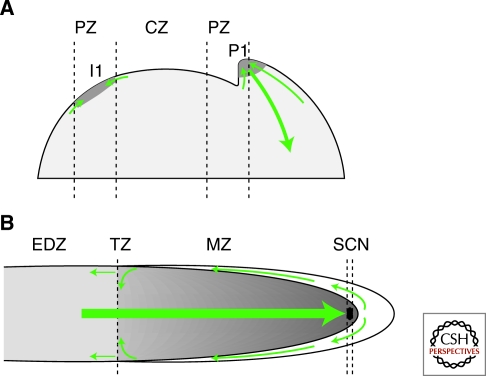Figure 4.
Auxin distribution and flux at the root and shoot apical meristems. Predicted auxin distribution is represented by shades of grey, where darker means higher concentration. Green arrows represent flux with arrowhead representing the direction of the flow and thickness is proportional to the flux of auxin. (A) In the shoot apical meristem, PIN-mediated auxin transport generates a discrete auxin maximum in the peripheral zone (PZ), known as the convergence point, which marks the site of the incipient primordium (I1). Above a certain threshold concentration, a lateral organ is initiated (in this case P1). Once the developing primordium reaches a certain stage, a new flux of auxin down and away from the convergence point is initiated, which guides the specification of vascular tissue. The distribution of auxin in the central zone (CZ) is still unknown and therefore has not be represented. (B) In the root meristem PIN-mediated polar transport generates an auxin maximum at the root tip that positions and maintains the stem-cell niche (SCN), and an auxin gradient throughout the meristematic zone (MZ) that sustains cell proliferation. Auxin is transported to the root tip through the central vascular tissue and then from the SCN is moved laterally and up and away from the tip. Importantly, a significant proportion of the basipetal auxin flow is refluxed back into the central acropetal flow at the transition zone (TZ). This system of polar auxin transport is predicted to generate a gradient of auxin that is very high in the SCN, moderately high in the meristematic zone (MZ) and much lower in the elongation/differentiation zone (EDZ).

